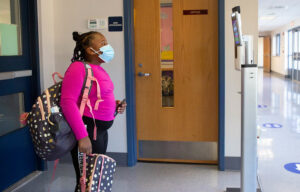
When a pediatric community-acquired pneumonia (CAP) guideline went into effect earlier this year, it got little use. That was fine by the team that developed it, led by pediatric pharmacist Bill Wilson and pediatrician Zach Willis, both with the Carolina Antimicrobial Stewardship Program. It meant that very few children needed to be hospitalized for pneumonia.
“The number of pneumonia cases we’d usually see at the hospital plummeted last fall and winter. Children can be efficient spreaders of the bacteria and viruses that cause pneumonia. Fortunately, the prevention measures that worked so well against COVID-19 –masking, handwashing, and distancing—also kept pneumonia at bay in kids,” Willis said.
“Now with a majority of kids back at daycare and in classrooms, we should expect to see a comeback in CAP. In fact, because kids haven’t been exposed to as many germs as usual, it could mean even more cases than a typical year. We also know that some kids have fallen behind on vaccinations during the pandemic, and they may be more susceptible to pneumonia for that reason.”
CAP is most commonly caused by a virus, bacteria, or a combination of the two. Widespread use of effective childhood vaccines that protect against certain bacterial pneumonias have made bacterial causes of pneumonia less common. However, childhood pneumonia from all causes remains a top reason for child hospitalization.
The CAP guideline was developed, in part, to help ensure antibiotics and other antimicrobials are selected with precision to address the root cause of the lung infection.
Wilson explains, “Before the guideline, it was not uncommon to see a less-than-optimal drug selected to treat the patient’s condition. It’s the role of antimicrobial stewardship pharmacists like me to intervene to ensure patients receive the right drug, at the right dose, for the right length of time. That’s one way to make sure our patients don’t experience any adverse effects associated with antimicrobial use. And another way is making that expertise available anytime through a guideline.”

Wilson, Willis, and a team of pediatric experts at UNC Children’s Hospital developed the guideline so that every provider has access to a tool that improves treatment decision-making at the ready. The guideline distills evidenced-based best practices into a short tool that clinicians can use to guide their diagnosis, treatment, and discharge plan for children with CAP. It is intended to serve as a complement to clinical judgment.
“We expect the number of pediatric CAP patients to at least return to typical pre-pandemic levels. That will give us an opportunity to assess the degree to which use of the guideline improves outcomes for our patients here at Children’s,” Wilson said.